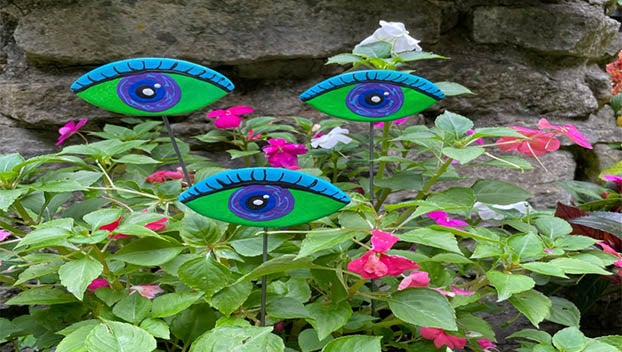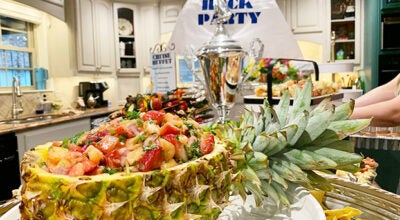MASTER GARDENER — Try these spooky plant selections for Halloween gardens
Published 12:04 am Thursday, October 27, 2022

- This pumpkin planter is inexpensive and made of plastic providing a festive plant display, but an organic option is to use a real pumpkin, which can be easily carved, then simply add plants with unusual characteristics. (Image courtesy of Amazon.com)
|
Getting your Trinity Audio player ready...
|
We’ve experienced a few chilly mornings, but temperatures have warmed nicely by midday, making garden work outside extremely gratifying. Now, if we could get some much-needed rainfall!
There are numerous plants which gardeners associate with Halloween, and various sorts of pumpkins and gourds have becomes staples for Halloween decorations.
The orange pumpkin is, hands down, the symbol most associated with Halloween in the United States. It’s an American icon! However, the holiday is All Hallows Eve, a time when ghosts could emerge from their realms and frightening occurrences happen during the night.
This opens many more possibilities for plant selection to use for a Halloween Garden. When you are selecting Halloween inspired plants, choose plants which have interesting or unusual characteristics.
That includes plants that only bloom during the night, have countless thorns, are predatory and carnivorous, or are shaded deep hues of purple or black, cast an eerie presence and hold our attention.
Halloween will be here soon, what a great time to involve children in selecting, planting and growing scary plants. Let them create a scary and spooky mood by designing a “petrifying” planter for an entryway, crafting a “frightening” front porch corner or planting a “howling” Halloween Garden of eerie potted plants.
The following groups of plants have noteworthy characteristics and would make deviously terrifying additions to a Halloween Garden.
To further enhance your Halloween Garden, combine Halloween décor into the planting aesthetic by adding items, such as eyeball plant markers, center plants around a witch’s hat, enlist zombie body parts into your motif or embed ghosts and spiders for the scariest effects.

Terrify visitors using these adorable eyeball plant markers within a Halloween Garden. (Image courtesy of Etsy.com)
Night Blooming Plants
Moonflowers (ipomoea alba) are vining plants with large white or pink trumpet-shaped blossoms, which open at sunset and close by noon the following day.
Flowering tobacco (Nicotinia alata) fills the night air with a jasmine-like scent.
Chocolate Daisy (Beranderia lyrate) is a flowering yellow plant that produces a sweet chocolate-like scent in the morning after blooming through the night.
Thorny Plants
Flying Dragon (Poncirus trifoliata) aka hardy orange, produces small, bitter oranges. It has unusual, twisted branches and sharp thorns.
Bed of Nails (Solanum quitoense) the fuzzy leaves are covered with inch long spines and are a member of the nightshade family. This certainly sends a chill down my spine!
Devil’s Walking Stick (Aralia spinosa) it has a spooky name and is a large deciduous shrub armed with sharp spiky stems, leaf stalks and branches. Topped with a crown of giant compound leaves.
Carnivorous Plants
Venus Flytrap meat-eating plants from the bogs of the Carolinas, digest insects which wander into their “traps.”
Pitcher Plant (Sarracenia flavia) insects are attracted to the plants alluring color, crawl about the flowers rim, and some fall into the pitcher which contains a sticky enzyme turning insects into ‘bug juice”, which feeds the plant.
Unusually Shaped & Deeply Hued Plants
Devils Trumpet (Datura) is a member of the nightshade family. Produces white to purple tinged flowers and spiny round seed pods.
Cockscomb (Celosia cristata) — the waviness of the cockscomb flowers is unique, closely resembling brains.
Rex Begonia (Begonia rex-cultorum) — the swirl patterns are hypnotic and fascinating. They are also called fancy-leaf Begonia, with numerous colorations of this plant from green, red, silver and dark purple.
Raven ZZ plant (Zamioculcas zamiifolia ‘Raven’) is waxy, shiny leaves, simply an elegant plant which would make a welcome addition to a Halloween Garden.
Elephant Ear (Colocasia ‘Black Magic’) leaves are a velvety purple black. Picture this situated at your homes entrance with a skull for Halloween decor, and you’ve got yourself an elegantly spooky arrangement.
Purple Oxalis (Oxalis triangulais) resembles a purple shamrock but with a dark, moody hue with shapes reminiscent of bats! They are a group of small plants grown from bulbs.
Here’s a brief bit of history about pumpkin carving into jack-o-lanterns, which is a relatively recent trend in the U.S. and abroad. Before pumpkins became popular, German children used to carve turnips and large Mangold.
Mangold is referred to as mangold-wurzel (mangelwurzel) or simply mangold in Germany, from where it originates. In German, ‘Mangold’ means “beet” and ‘wurzel’ means “root,” which is what mangold vegetables are.
So, now my fellow gardeners, let’s go out and grow ourselves a greener, more sustainable world, one “spooky” plant, at a time! Happy Halloween everyone, be safe!
John Green is a Certified Texas Master Gardener. If you have gardening questions or need more information, contact the Orange County Master Gardeners Helpline at 409-882-7010 or visit txmg.org/orange, Orange County Texas Master Gardeners Association on Facebook or email extension@co.orange.tx.us.





